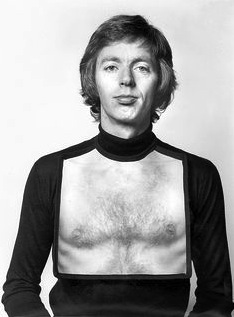
Earliest use of photos in jewelry were locket-style portraits, an extension of the painted miniatures people were wearing by the 17th century. As we saw in part one of this series, the instinct to wear loved ones close to the heart has evolved into a trend to make art jewelry out of total strangers… and sometimes ourselves.
Yes, the current obsession with selfies has entered the realm of art jewelry. If Gijs Bakker is any indication, it happened long before the term “selfie” even existed.
But most of the 80 pieces of jewelry that appeared in the recent exhibit at the Museum of Arts and Design in NYC – and current book, Multiple Exposures: Jewelry and Photography – are less portraiture and more what curator Ursula Ilsa Neuman calls narrative jewelry.
“This is jewelry that’s telling a story, literally,” Neuman says. “And what’s interesting is that the photographs used and culled from various sources – now the Internet and so on – change when they’re incorporated into wearable objects. And the wearable objects get their meaning through the photography. So there is a really good cross-influence and cross-fertilization between the two.”
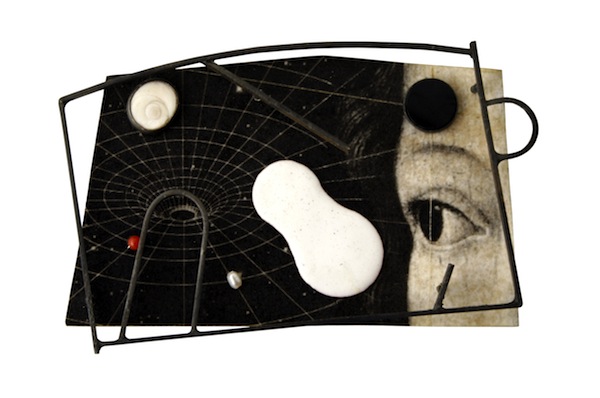
Among the materials listed as “Internet images” in work by artist Ramon Puig Cuyàs is an eye from Leonardo da Vinci painting, which seems to peer out at the rest of the brooch. Cuyàs reworks a fragment of that painting, scanned and pulled from the Web, building tiny mixed-media “paintings” of his own, using enamel and acrylic resin with embellishments of onyx, shell, pearl, coral, or quartz, then framing them, slightly askew, in silver.
A special treat of the exhibit is a nine-piece retrospective of the photo-jewelry by Gijs Bakker, prominent Dutch jewelry and industrial designer who cofounded Droog Designs. They date to 1976 when Bakker playfully created a bib printed with a black-and-white photo of his own bare chest and another with a woman’s bare chest, so the wearer ends up with a chest on his (or her) chest.
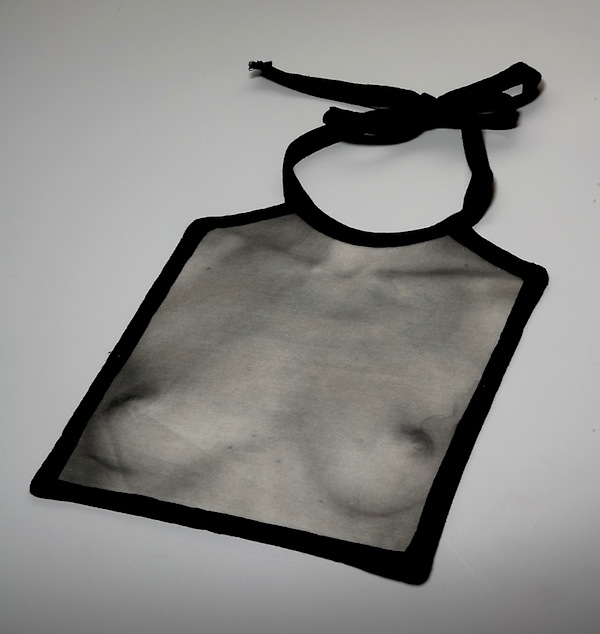
In another two-foot wide neckpiece, Bakker photographed himself from above with arms crossed so he appears to be hugging the wearer. (The piece is called “Embracement.”) “Those were tongue-in-cheek, self reverential and just fun,” Neuman says.
Most famous Bakker piece on display, however, is the “Waterman” brooch, made in 1991 from a photograph by fashion photographer Bruce Weber of a crouching, Adonis-like male tipping a bucket over his head. Bakker bought the image as a postcard from a secondhand store in New Orleans, then embellished it with white gold and diamonds that resemble water droplets flowing from the bucket down the model’s muscular back.
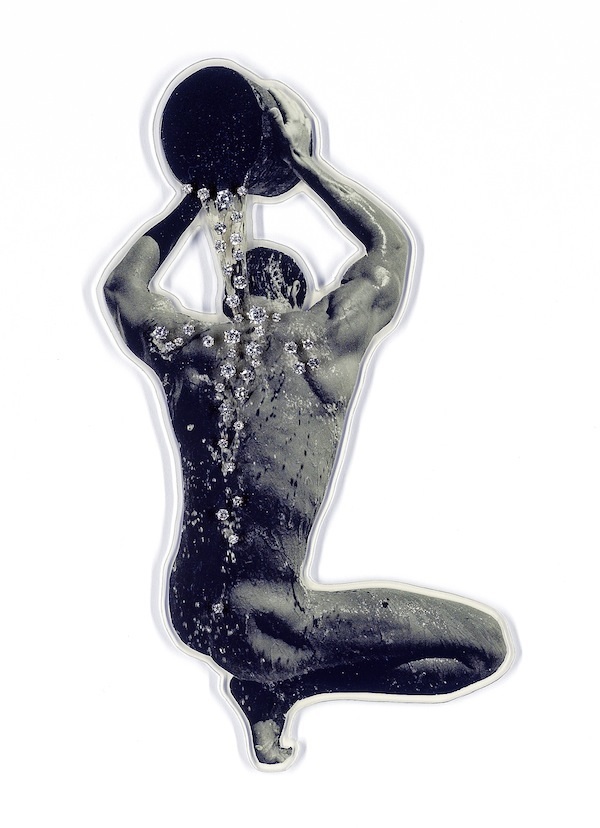
I asked Neuman if artists were ever faced with issues of copyright infringement when making this kind of derivative art-about-art. “These images are on the Internet already,” Neuman says. “Many of them are downloaded, so they’re really common property. This is really a phenomenon of the last 15 years, a sign of our time. Even images from Google, the street views, are common property now.”
Like Bakker, many of the featured artists alternate between their own and reworked existing images. Assemblage artist Kiff Slemmons works with old photographs, taking them apart and putting them together in a way that gives them new meaning. In “The Reliquary of My Own Making” necklace, Slemmons took images of her own hands making things, encased them in mica, and set them in geometric silver forms that link together like a puzzle. “This, in a way, is a self portrait too,” Neuman observes.
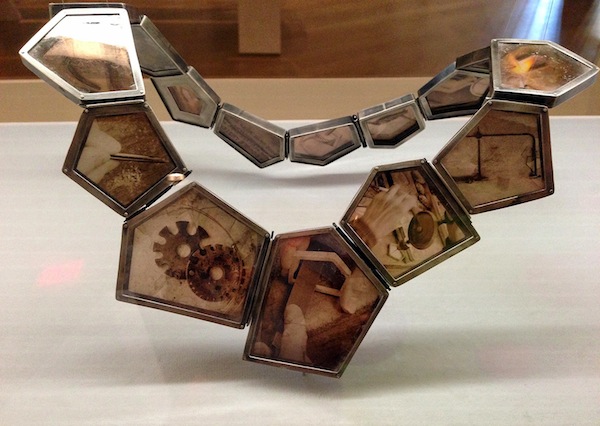
German artist Bettina Speckner also alternates between her own photographs and reworked old tin-types, often using sections of landscape and obscuring them with bits of gemstone. One brooch resembles an oval of picture jasper until you look closer and realize it’s a photographic image enameled onto silver. In other brooches, Speckner etches her photographs on zinc. The results are very mysterious, often romanticized.
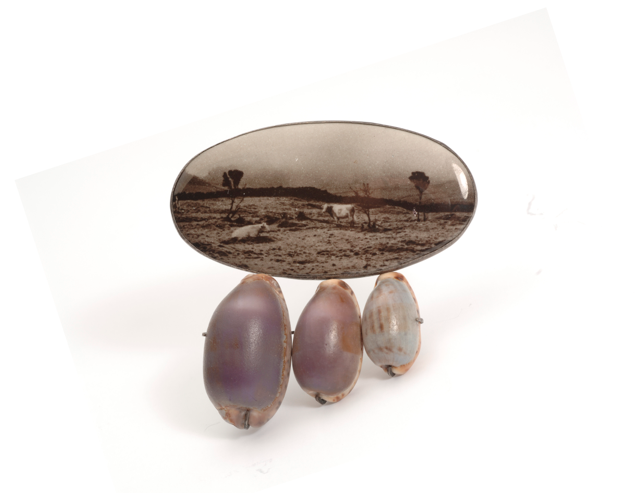
Another section of Multiple Exposures: Jewelry and Photography involves jewelry made from camera parts. Jiro Kamata, for example, uses camera lenses as a container of memory, sometimes painting them, sometimes inserting mirrors to reflect something. “These are sort of an expression of what would have been seen through these lenses,” Neuman says. “It’s very interesting, very beautiful work.”
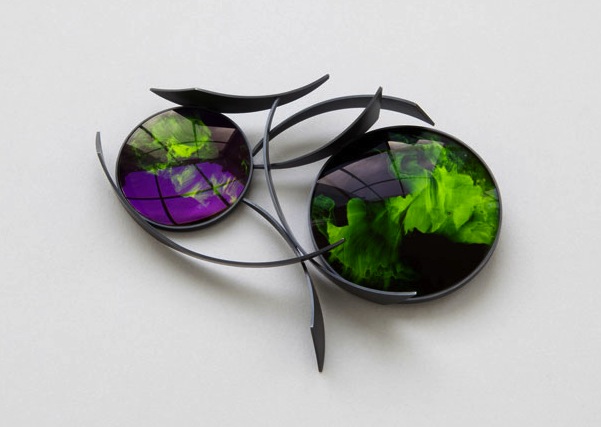
Jewelry and Photography wraps up with a section of video about jewelry – the philosophy, symbolism and social aspects of jewelry, jewelry considered in terms of value, the ritual of putting it on and taking it off. In one video, a woman is literally overloaded with jewelry and collapses under the weight.
Neuman says she wanted to focus on the merging of jewelry and photography because it’s such fertile ground for jewelry artists today. “This is an incredibly active field which speaks to our times,” she says. “It deals with contemporary issues – political issues, the body – and not only the beautiful body but also the diseased body or the unsightly body. It can deal with personal or culturally important issues. It’s a phenomenon that is steadily growing.”
It’s also a form of jewelry-making that appeals to the intellect. “It can be a challenge for the jewelry maker to incorporate a two-dimensional image into a three-dimensional object, to see the changes and transformations that occur,” Neuman says. “Part of the challenge is to decide what you crop from that photograph: What’s the important statement of that photograph and how do I incorporate it into a ring or a necklace? What do I want to express?”
“These two media influence each other,” she says. “And when you use them together to create something totally new, you can produce a very interesting hybrid object.”
(Excerpted from an article published in Lapidary Journal Jewelry Artist magazine.)
Related posts
Helen Drutt: advocate of contemporary studio jewelry
Melanie Bilenker: Victorian-inspired hair jewelry
Jewelry by Picasso: the secret stash of Dora Maar
How to photograph jewelry: DIY tips from successful designers
Related products
Shopping via these links doesn’t cost you extra but provides a small commission for maintenance of this blog.

